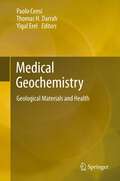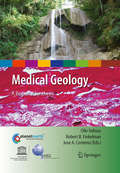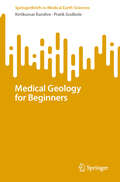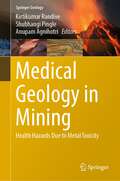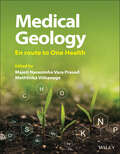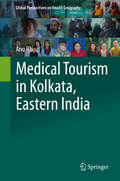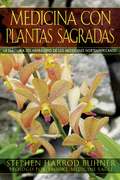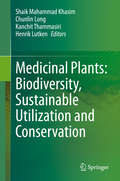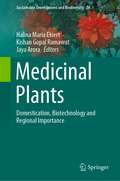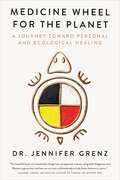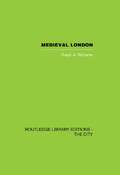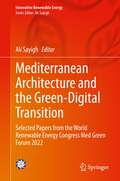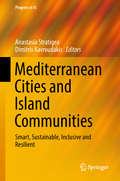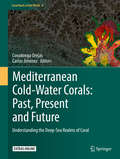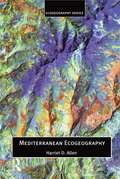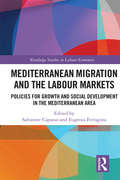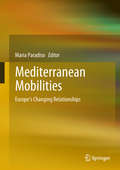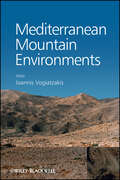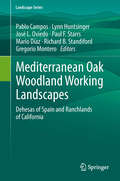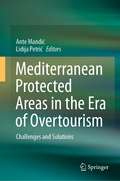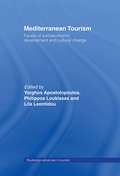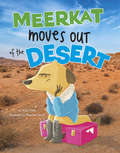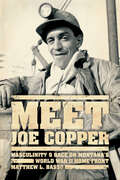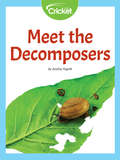- Table View
- List View
Medical Geochemistry
by Paolo Censi Thomas Darrah Yigal ErelThis book includes a collection of chapters illustrating the application of geochemical methods to investigate the interactions between geological materials and fluids with humans. Examples include the incorporation and human health effects of inhaling lithogenic materials, the reactivity of biological fluids with geological materials, and the impact on nascent biomineral formation. Biomineralization is investigated in terms of mineralogy, morphology, bone chemistry, and pathological significance with a focus on the health impacts of "foreign" geological/environmental trace element incorporation. One of the contribution is devoted to particulate matter, the presence of metals and metalloids in the environment, and the possibility of using human hair as a biomarker between environmental/geological exposure and human bioincorporation. Other chapters focus on the last advances on the analytical methods and instrumentational approaches to investigating the chemistry of biological fluids and tissues.
Medical Geology
by Jose A. Centeno Olle Selinus Robert B. FinkelmanMedical Geology is a rapidly growing field concerned with the relationship between natural geological factors and human and animal health, as well as with improving our understanding of the influence of environmental factors on the geographical distribution of health problems. This book brings together the work of geoscientists and medical/public health researchers, which addresses health problems caused, or exacerbated by geological materials (rocks, minerals, atmospheric dust and water) and processes (including volcanic eruptions and earthquakes. Among the environmental health problems discussed in this book are: exposure to toxic levels of trace essential and non-essential elements such as arsenic and mercury; trace element deficiencies; exposure to natural dusts and to radioactivity; naturally occurring organic compounds in drinking water; volcanic emissions, etc. The text also deals with the many health benefits of geologic materials and processes. This wide-ranging volume covers issues in medical geology all over the world with each author covering their respective region. It provides examples from different continents as well as a state-of-the-art review of the latest developments in the discipline. The authors are all recognized geoscientific and medical experts working in the field. The book is written for a wide variety of specialists from geologists, geochemists, pathologists and medical doctors to veterinarians and biologists.
Medical Geology for Beginners (SpringerBriefs in Medical Earth Sciences)
by Kirtikumar Randive Pratik GodboleThis book is created for a diverse audience that includes geologists and Earth scientists studying the impacts of geological processes on human health, as well as health professionals and medical researchers interested in the environmental determinants of health. It is also a good reference for the environmental scientists and public health policymakers focused on sustainable practices and health risk mitigation. Additionally, undergraduate and postgraduate students, research scholars, and academicians in geosciences, environmental health, and related interdisciplinary fields will find this book valuable for their studies and research. Industry professionals in mining, environmental monitoring, and disaster management will benefit from the health insights provided. Furthermore, individuals working in Ayurveda and traditional medicine will discover valuable information on the therapeutic uses of geological materials. This book explores relationship between geology and human health, providing vital insights for professionals in both the geosciences and health sciences. It delves into how natural processes, materials, and anthropogenic activities influence human health, highlighting the critical role of Medical Geology in modern science and public health. Finally, as Professor Robert Finkleman narrates, &“Medical Geology for Beginners provides an invaluable service to the science of medical geology and to anyone interested in this subject matter and especially to the young readers who may be inspired to pursue a career in medical geology&”.
Medical Geology in Mining: Health Hazards Due to Metal Toxicity (Springer Geology)
by Kirtikumar Randive Shubhangi Pingle Anupam AgnihotriThis book discusses a wide range of health-related mining issues, with particular reference to occupational diseases, metal toxicity, postural injuries in miners, modern fire safety controls, noise-induced hearing loss prevention, and noise mapping. Mining plays a central role in the development of modern civilization. By providing the essential raw materials, mining ensures progress, safety, and comfort of people. However, this necessary activity comes with several woes, the most important of which are occupational health hazards. Mines act as sources of constant danger and risk to the miners irrespective of the scale of mining, such as large-scale industrial mining or small-scale artisanal mining. Not only are there accidents, but continuous exposure to dust, metal toxicity, hazardous gases and fumes, and loud noises, giving rise to a variety of diseases to mine workers. The comprehensive coverage of issues and the case studies will make this book an essential reference and critical reading. Medical geology is a necessary discipline in earth sciences. Unfortunately, not much literature is available on this subject. Therefore, this book is essential for practicing engineers and supervisors in mines, health and safety professionals, researchers, and mining industry students.
Medical Geology: En route to One Health
by Majeti Narasimha Vara Prasad Meththika VithanageMedical Geology The key to understanding the relationship between the geological environment and human health Medical geology deals with of the impact of environmental factors on the health of individual human beings and communities. In particular, it studies environmental exposure to both macro- and micronutrients in the geosphere, hydrosphere, and atmosphere—respectively, soil, water, and airborne dust—which may positively or negatively impact human growth, development, and overall health. The insights contributed by this burgeoning field can aid not only in individual medical cases, but also in assessing disproportionately impacted communities and addressing global medical inequality. Medical Geology: En route to One Health is among the first books to address this vital subject by summarizing recent research in this field. It also serves as an introduction to the multidisciplinary One Health methodology, which unites medical, geological, and environmental insights in one continuous approach to public health. Medical Geology readers will also find: An explanation of the influence of the environment on nutrient availability Case studies of well-documented links between endemic diseases and environmental conditions A systematic analysis of the causes of essential element deficiencies in different world regions Medical Geology is an essential overview of the field, for advanced students as well as medical, environmental, or geological researchers who wish to understand the complex relationship between the geological environment and human health.
Medical Tourism in Kolkata, Eastern India (Global Perspectives on Health Geography)
by Anu RaiThis book examines the global influence and scope of medical tourism with an emphasis on the city of Kolkata in Eastern India as an emerging destination at the regional scale. Through a geographical research perspective, the book discusses the importance of the phenomenon of medical tourism including recent trends, policies, and scale studies to develop sustainable strategies for medical tourism at particular micro destinations. In nine chapters, readers will become familiar with the multi-billion dollar industry of medical tourism and the problems currently associated with medical tourism at multiple scales. The trends of medical tourism in and around the city of Kolkata are used to demonstrate the roles of infrastructure and stakeholders in implementing feasible and sustainable medical tourism in an emerging destination.The first two chapters of the book provide an introduction to medical tourism and the methodologies of this study. Then chapters three through nine focus on medical tourism in the case of Kolkata to discuss the regional applications and developments of medical tourism. Topics addressed include medical tourism facilities, stakeholders and tourists, guest-host relationships, an assessment of development versus risk, and an evaluation of strategies to manage rising medical tourism in Kolkata. The concluding chapter discusses future strategies that could be used to implement the potentialities of a metropolitan city as a medical tourism destination, based on studies done in Kolkata. Readers who will find this work of interest include students, practitioners, geographers, and researchers and policymakers engaged in the medical tourism industry.
Medicina con plantas sagradas: La sabiduría del herbalismo de los aborígenes norteamericanos
by Brooke Medicine Eagle Stephen Harrod BuhnerEl primer examen en profundidad de los fundamentos sagrados del mundo del herbalismo medicinal de los aborígenes norteamericanos • Revela cómo los chamanes y sanadores “hablan” con las plantas para descubrir sus propiedades medicinales • Incluye las oraciones y canciones medicinales vinculadas con el uso de cada una de las plantas examinadas A medida que los seres humanos evolucionaron en la Tierra, utilizaron plantas para todo lo imaginable --alimentos, armas, canastas, vestimentas, refugio y remedios de salud. En su libro Medicina con plantas sagradas, Stephen Harrod Buhner analiza la relación de larga data entre los pueblos aborígenes y las plantas y examina las técnicas y estados mentales que utilizan estas culturas para comunicarse con el mundo botánico. El autor explora la dimensión sagrada de las interacciones entre seres humanos y plantas --un territorio en el que los humanos experimentamos la comunicación con las plantas como expresiones del Espíritu. Con respecto a cada planta curativa descrita en el libro, el autor presenta sus usos medicinales, normas para su preparación y elementos ceremoniales como las oraciones y canciones medicinales vinculadas con el uso de la planta.
Medicinal Plants: Biodiversity, Sustainable Utilization and Conservation
by Shaik Mahammad Khasim Kanchit Thammasiri Chunlin Long Henrik LutkenPlants have been a source of medicines and have played crucial role for human health. Despite tremendous advances in the field of synthetic drugs and antibiotics, plants continue to play a vital role in modern as well as traditional medicine across the globe. In even today, one-third of the world’s population depends on traditional medicine because of its safety features and ability to effectively cure diseases. This book presents a comprehensive guide to medicinal plants, their utility, diversity and conversation, as well as biotechnology. It is divided into four main sections, covering all aspects of research in medicinal plants: biodiversity and conservation; ethnobotany and ethnomedicine; bioactive compounds from plants and microbes; and biotechnology. All sections cover the latest advances. The book offers a valuable asset for researchers and graduate students of biotechnology, botany, microbiology and the pharmaceutical sciences. It is an equally important resource for doctors (especially those engaged in Ayurveda and allopathy); the pharmaceutical industry (for drug design and synthesis); and the agricultural sciences.
Medicinal Plants: Domestication, Biotechnology and Regional Importance (Sustainable Development and Biodiversity #28)
by Kishan Gopal Ramawat Halina Maria Ekiert Jaya AroraMedicinal plant research is an evergreen subject. There is a tremendous increase in popularity of herbal medicine in traditional medicine, ethnomedicine, modern medicine and as over the counter food supplements. Even after this increased demand, supply is neither uniform nor assured as most of these plants are collected from wild. In developing countries of tropical and subtropical regions where majority of herbal drugs are produced, this is not organised sector making it vulnerable to several malpractices, hence standardization of all aspects required. This has also negative impact on biodiversity and conservation of plants as well as supply of uniform material. This book is aimed to provide up to date information about sustainable use of selected medicinal plants, their active ingredients and efforts made to domesticate them to ensured uniform supply. Development of agrotechnology, biotechnology and cultivation practices using conventional and non-conventional methods are presented. Where these efforts will lead the medicinal plant research and future perspective are discussed. The chapters are written by well recognised group leaders in working in the field. The book contains topics on general biology of medicinal plants, their sustainable use and, cultivation and domestication efforts. A uniform chapter structure has been designed to keep consistency. The book will be useful for academicians, agriculturists, biotechnologists and researcher, and industries involved in manufacturing herbal drugs and supplementary products.
Medicine Wheel for the Planet: A Journey Toward Personal and Ecological Healing
by Jennifer GrenzA personal journey of bringing together Western science and Indigenous ecology to transform our understanding of the human role in healing our planetI used to be an ecologist. . . . Now, I am a community gatherer, working to help bring healing beyond just the land. I am a story-listener. I am a storyteller. I am a shaper of ecosystems. I work on bringing communities together, in circle, to listen to each other. A farm kid at heart, and a Nlaka&’pamux woman of mixed ancestry, Dr. Jennifer Grenz always felt a deep connection to the land. However, after nearly two decades of working as a restoration ecologist in the Pacific Northwest, she became frustrated that despite the best efforts of her colleagues and numerous volunteers, they weren&’t making the meaningful change needed for plant, animal, and human communities to adapt to a warming climate. Restoration ecology is grounded in an idea that we must return the natural world to an untouched, pristine state, placing humans in a godlike role—a notion at odds with Indigenous histories of purposeful, reciprocal interaction with the environment. This disconnect sent Dr. Grenz on a personal journey of joining her head (Western science) and her heart (Indigenous worldview) to find a truer path toward ecological healing. In Medicine Wheel for the Planet, building on sacred stories, field observations, and her own journey, Dr. Grenz invites readers to share in the teachings of the four directions of the medicine wheel: the North, which draws upon the knowledge and wisdom of elders; the East, where we let go of colonial narratives and see with fresh eyes; the South, where we apply new-old worldviews to envision a way forward; and the West, where a relational approach to land reconciliation is realized. Eloquent, inspiring, and disruptive, Medicine Wheel for the Planet circles around an argument that we need more than a singular worldview to protect the planet and make the significant changes we are running out of time for.
Medieval London
by Gwyn A. WilliamsThis unique study is based on the careful interpretation of evidence in the commercial and administrative records of the City and in the royal records, of the process by which London developed from a commune of a feudal kingdom into the capital city of the English nation. The period covered is the century and a half between 1191 and the beginnings of the Hundred Years' War. Leading themes are the emergence of its administrative elite, the changing pattern of its mercantile interests, and the rise of its craft organizations; and a detailed account is given of the social and constitutional conflicts that marked London's history between the popular revolt of 1263 and the succession of Edward III. A notable feature of this volume is the reconstruction from teh records of a large number of outline biographies of Londoners of all classes. This book was first published in 1963.
Mediterranean Architecture and the Green-Digital Transition: Selected Papers from the World Renewable Energy Congress Med Green Forum 2022 (Innovative Renewable Energy)
by Ali SayighThis book contains selected papers presented during the World Renewable Energy Network’s biannual World Med Green Forum (MGF). The 2022 MGF highlights the role of renewable energy applications in the sustainable building sector with a focus on the Mediterranean region as a foundation for a truly positive energy future. MGF is an open roundtable for an international community of researchers, practitioners, and experts to discuss the most innovative and promising sustainable building technologies. The papers presented explore the intersection between twin transitions in policies, programs, projects, and experimentation, with the digital domain innovating the green building sector towards more reliable and inclusive planning and design practices in order to collectively envision future buildings and cities.
Mediterranean Cities and Island Communities: Smart, Sustainable, Inclusive and Resilient (Progress in IS)
by Anastasia Stratigea Dimitris KavroudakisThis book addresses the issue of smart and sustainable development in the Mediterranean (MED) region, a distinct part of the world, full of challenges and risks but also opportunities. Above all, the book focuses on smartening up small and medium-sized cities and insular communities, taking into account their geographical peculiarities, the pattern of MED urban settlements and the abundance of island complexes in the MED Basin. Taking for granted that sustainability in the MED is the overarching policy goal that needs to be served, the book explores different aspects of smartness in support of this goal’s achievement. In this respect, evidence from concrete smart developments adopted by forerunners in the MED region is collected and analyzed; coupled with experiences gathered from successful, non-MED, examples of smart efforts in European countries. More specifically, current research and empirical results from MED urban environments are discussed, as well as findings from or concerning other parts of the world, which are of relevance to the MED region. The book’s primary goal is to enable policymakers, planners and decision-making bodies to recognize the challenges and options available; and make to more informed policy decisions towards smart, sustainable, inclusive and resilient urban and regional futures in the MED.
Mediterranean Cold-Water Corals: Understanding the Deep-Sea Realms of Coral (Coral Reefs of the World #9)
by Covadonga Orejas Carlos JiménezWhat do we know about Mediterranean Cold (Deep)-Water coral ecosystems? In this book, specialists offer answers and insights with a series of chapters and short papers about the paleoecology, biology, physiology and ecology of the corals and other organisms that comprise these ecosystems. Structured on a temporal axis—Past, Present and Future—the reviews and selected study cases cover the cold and deep coral habitats known to date in the Mediterranean Basin. This book illustrates and explains the deep Mediterranean coral habitats that might have originated similar thriving ecosystems in today’s Atlantic Ocean.
Mediterranean Ecogeography (Ecogeography Series)
by Harriett AllenA core textbook series that aims to provide students with accessible, up-to-date accounts of Ecogeography - the marriage of ecology with geography - in the primary terrestrial and marine environments. This is the first book in the series on Mediterranean Ecogeography. Biological diversity in the Mediterranean Basin is amongst the highest of any region on earth, both in terms of total species numbers and endemism. The flora is estimated at about 25,000 species of flowering plants and ferns, compared with about 6000 species in non-Mediterranean Europe. About 50% of these are endemic. Diversity amongst vertebrate animals is also high, though endemism rates are lower than for plants. The high levels of diversity contribute to, and are a reflection of, the considerable variability of landscape. This results from a combination of factors including geological and tectonic history, relief and physiography, climate, geomorphological processes, hydrology, soils, the incidence of fires and impact of human activities. The landscapes of the Mediterranean Basin are thus varied and fragmented; a mosaic of ecosystems and communities. Mediterranean Ecogeography aims to examine and explain this heterogeneity, and the approach is focused on the ecogeography of the region. Analysing the factors which account for the present distributions of plants and animals, and the functioning of ecosystems within the Mediterranean Basin can help in the understanding of the relationship between people and natural ecosystems. A key to the conservation of these ecosystems is the wise use of resources, biological and physical. In addition, it is vital to assess how the natural environments of the region will respond to further change. In the last twenty years, understanding of the functioning of mediterranean-type ecosystems has advanced through several international projects. This book draws upon the findings of these, and other research in the Mediterranean Basin, to present a comprehensive text on a key region of the world, and the problems and prospects of its environmental exploitation.
Mediterranean Migration and the Labour Markets: Policies for Growth and Social Development in the Mediterranean Area (Routledge Studies in Labour Economics)
by Salvatore CapassoThis book focuses on issues that are relevant for the Euro-Mediterranean Partnership. The depth and the extension of the current political crisis in the area have changed the perspectives of conventional Euro-Mediterranean integration policies. The book provides the grounds for new patterns of analysis and addresses policy guidelines which are able to respond to the dramatic challenges that Mediterranean regions are facing. By implementing a multidisciplinary approach, the volume uncovers the structural determinants of migrations in the area: territorial and social imbalances, climate change, unemployment, weak institutions, poor governance, lack of efficient redistributive policies. Each chapter proposes innovative and rich analyses of the socio-economic conditions of all Mediterranean countries. The prevailing evidence suggests that while the North-South imbalances still persist inside the basin, the recent world economic and financial crises have deepened social, intergenerational and gender inequalities. These inequalities cross all territories both nationally and internationally and affect the living conditions of large segments of population in Southern and Eastern Mediterranean countries. To bridge these gaps it is necessary to strengthen territorial cohesion, reduce income differentials, and improve the access of marginal areas to basic infrastructure. These long term goals can be achieved through an inclusive development model for which young people and women can enjoy the same opportunities of education and work. Offering innovative and practical guidelines for future programs and policies, this book is essential reading for policy makers, researchers at policy think tanks as well as academics and post graduate students of Mediterranean studies and Economic Policy. The general policy recipes, provided to govern migration flows, make useful reading for national and international research centres and major governmental agencies interested in migration issues.
Mediterranean Mobilities: Europe's Changing Relationships
by Maria ParadisoThis book critically assesses mobilities across the Mediterranean Basin and explores the implications of changing European relationships in the light of observations of the intersectional formation and evolution of identities, behavior and ideas. Further, it discusses the timely topic of a new diversity of migration and mobility practices (personal and virtual mobilities in terms of gender, motivations, emotional geographies, impacts, and circulation) from conceptual and empirical perspectives, providing new insights for scholars and policy makers in the context of urgently needed national and European policies. Mediterranean Mobilities is based on fieldwork in European and non-European countries and on mutual learning and transfer of knowledge among scholars from nine universities in Morocco, Algeria, Israel, Ireland, Italy, Portugal and Spain, as well as stakeholders in Europe and North Africa. The results stem from the FP7 Marie Curie IRSES project MEDCHANGe coordinated by the book editor. The project comprises fieldwork conducted by distinguished scholars in Europe, Morocco, Algeria and Israel, generating original data and findings on fast changing realities. This book appeals to researchers but also serves as a basic or complementary text in advanced undergraduate, graduate or master’s courses on mobilities/migration, regionalization, cooperation, international relations and Mediterranean studies as part of teaching programs in geography, sociology, international political sciences, as well as programs focusing on regional studies (e.g., European integration). It is also of interest to the professional and institutional community in the wide area of Mediterranean politics, economy and society as well as a general readership.
Mediterranean Mountain Environments
by Ioannis VogiatzakisMediterranean mountains exhibit many similarities in their biotic ecological, physical and environmental characteristics. There are also many differences in terms of their human colonization pattern, historic land uses and current anthopogenic pressures. This book provides an introduction to these environments of mountainous areas in the Mediterranean and their changes in time and space in relation to both natural and cultural factors.Mediterranean Mountain Environments places its emphasis on physical geography while adopting an integrated approach to the whole subject area. The book draws examples from a wide range of environments, demonstrating the interaction between human and physical processes responsible for shaping mountain areas. Risks and conflicts, as well as methods and tools for the conservation and management of both the natural and cultural environment are covered in the light of future challenges for the sustainable development of the Mediterranean mountains.Emphasis on both mainland and island mountain rangesCombines natural and cultural approach in the topicIntegrated approach: facing future challenges based on the study and understanding of the historical processes that have shaped the Mediterranean mountainsKey references at the end of each chapter
Mediterranean Oak Woodland Working Landscapes
by Gregorio Montero Jose Luis Oviedo Pro Lynn Huntsinger Mario Diaz Pablo Campos Paul F Starrs Richard B StandifordThe oak tree was a boon companion as humans expanded their presence across much of the globe. While oak woodlands (Quercus spp.) come today in stunningly diverse forms, the stately dehesas of Spain and the dramatic oak-dominated ranchlands of California are working landscapes where cultivation and manipulation for a couple of millennia have shaped Mediterranean-type ecosystems into a profoundly modified yet productive environment that is sought-after by every manner of species. The grazing of wildlife and livestock in oak woodlands yields a remarkable plant and animal biodiversity, creating a mosaic of habitats and visually pleasing savannas. Added products unique to Spain such as Iberian pigs and cork, and in California multiple landowner benefits, include valued ecosystem services that allow owners, visitors, and conservation supporters to experience the benefits of woodland life. With its 15 chapters a decade in the making, this handsomely illustrated book covers key topics in oak woodland policy, ecology, and management in Spain and California, presenting new research results and reviewing an existing expert literature.
Mediterranean Protected Areas in the Era of Overtourism: Challenges and Solutions
by Ante Mandić Lidija PetrićThis book comprises studies that reflect on various influences of excessive tourism development in protected areas, and solutions designed and initiated to mitigate such challenges. A large proportion of tourism in Mediterranean destinations constitutes nature-based tourism, in particular, tourism in parks and protected areas. As a destination experiences higher intensity and density of tourism, the potential conflict between maintaining a healthy natural environment and economic development also increases. This has urged planners and decision-makers to devise and adopt innovative approaches that seek to strike a balance between tourism development and nature conservation. This book demonstrates the importance of collaboration across and beyond disciplines and of all groups of stakeholders for maximization of societal impacts and tourism-related benefits.
Mediterranean Tourism: Facets of Socioeconomic Development and Cultural Change (Routledge Advances in Tourism #4)
by Lila Leontidou Yorghos Apostolopoulos Philippos LoukissasThis book comments on the complexities of Mediterranean tourism, with contributions from researchers, consultants, managers and advisors from thirteen countries. It is an excellent reference tool for undergraduate and postgraduate students, as well as industry practitioners, for the examination of tourism in different Mediterranean contexts.
Meerkat Moves Out of the Desert (Habitat Hunter)
by Nikki PottsMeerkat is bored with its habitat! Follow Meerkat as it tries out different places to live. Which habitat will make the best home for Meerkat?
Meet Firefighter Greg
by Amy TaoFirefighter Greg has a physical job to do so he stays strong and fit. He gets up early in the morning and sleeps where he works. Did you know that Firefighter Greg practices putting on his safety gear–in less than one minute? Or that his gear–helmet, facemask, air pack, boots and jacket–weighs 75 pounds? Find out how firefighters practice putting out fires in a training tower!
Meet Joe Copper: Masculinity and Race on Montana's World War II Home Front
by Matthew L. BassoOC I realize that I am a soldier of production whose duties are as important in this war as those of the man behind the gun. OCO So began the pledge that many home front men took at the outset of World War II when they went to work in the factories, fields, and mines while their compatriots fought in the battlefields of Europe and on the bloody beaches of the Pacific. The male experience of working and living in wartime America is rarely examined, but the story of men like these provides a crucial counter-narrative to the national story of Rosie the Riveter and GI Joe that dominates scholarly and popular discussions of World War II. In "Meet Joe Copper," Matthew L. Basso describes the formation of a powerful, white, working-class masculine ideology in the decades prior to the war, and shows how it thrivedOCoon the job, in the community, and through union politics. Basso recalls for us the practices and beliefs of the first- and second-generation immigrant copper workers of Montana while advancing the historical conversation on gender, class, and the formation of a white ethnic racial identity. "Meet Joe Copper" provides a context for our ideas of postwar masculinity and whiteness and finally returns the men of the home front to our reckoning of the Greatest Generation and the New Deal era.
Meet the Decomposers
by Anisha YagnikDid you know food scraps you throw away help plants and vegetables grow? Scavengers, animals who eat our food scraps, and decomposers: bacteria, fungi, and insects break the food down into soil. They eat some and put the rest into the soil we use for planting and gardening. Can you guess which animals and bugs make the best decomposers? What are scientists learning about decomposers?
